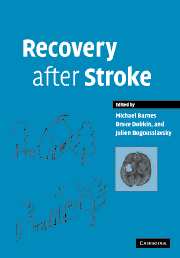Book contents
- Frontmatter
- Contents
- List of authors
- Preface
- 1 Stroke: background, epidemiology, etiology and avoiding recurrence
- 2 Principles of recovery after stroke
- 3 Regenerative ability in the central nervous system
- 4 Cerebral reorganization after sensorimotor stroke
- 5 Some personal lessons from imaging brain in recovery from stroke
- 6 Measurement in stroke: activity and quality of life
- 7 The impact of rehabilitation on stroke outcomes: what is the evidence?
- 8 Is early neurorehabilitation useful?
- 9 Community rehabilitation after stroke: is there no place like home?
- 10 Physical therapy
- 11 Abnormal movements after stroke
- 12 Spasticity and pain after stroke
- 13 Balance disorders and vertigo after stroke: assessment and rehabilitation
- 14 Management of dysphagia after stroke
- 15 Continence and stroke
- 16 Sex and relationships following stroke
- 17 Rehabilitation of visual disorders after stroke
- 18 Aphasia and dysarthria after stroke
- 19 Cognitive recovery after stroke
- 20 Stroke-related dementia
- 21 Depression and fatigue after stroke
- 22 Sleep disorders after stroke
- 23 Technology for recovery after stroke
- 24 Vocational rehabilitation
- 25 A patient's perspective
- Index
10 - Physical therapy
Published online by Cambridge University Press: 05 August 2016
- Frontmatter
- Contents
- List of authors
- Preface
- 1 Stroke: background, epidemiology, etiology and avoiding recurrence
- 2 Principles of recovery after stroke
- 3 Regenerative ability in the central nervous system
- 4 Cerebral reorganization after sensorimotor stroke
- 5 Some personal lessons from imaging brain in recovery from stroke
- 6 Measurement in stroke: activity and quality of life
- 7 The impact of rehabilitation on stroke outcomes: what is the evidence?
- 8 Is early neurorehabilitation useful?
- 9 Community rehabilitation after stroke: is there no place like home?
- 10 Physical therapy
- 11 Abnormal movements after stroke
- 12 Spasticity and pain after stroke
- 13 Balance disorders and vertigo after stroke: assessment and rehabilitation
- 14 Management of dysphagia after stroke
- 15 Continence and stroke
- 16 Sex and relationships following stroke
- 17 Rehabilitation of visual disorders after stroke
- 18 Aphasia and dysarthria after stroke
- 19 Cognitive recovery after stroke
- 20 Stroke-related dementia
- 21 Depression and fatigue after stroke
- 22 Sleep disorders after stroke
- 23 Technology for recovery after stroke
- 24 Vocational rehabilitation
- 25 A patient's perspective
- Index
Summary
Introduction
The aim of this chapter is to present an overview of different physical therapy strategies for the rehabilitation of people who have had a stroke. We will start with a brief historical outline of the classic physiotherapy approaches and the evidence currently available regarding their efficacy. Next, we will discuss a number of current and emerging physiotherapy interventions. Since physiotherapy encompasses a wide variety of treatment modalities – a comprehensive description of which is beyond the scope of this chapter – we have selected strategies that are particularly relevant to the management of movement problems in stroke rehabilitation. Specific issues related to orofacial, bowel, bladder, and sexual function are discussed in chapters 14–16, while pain management is discussed in chapter 12. For a more comprehensive account of neurological physiotherapy in general, the reader is referred to other textbooks (e.g. Ada and Canning, 1990; Edwards, 2002; Stokes, 2004). Finally, the chapter presents a case study that illustrates a range of physiotherapy strategies which could be provided from the acute to the chronic stage after stroke.
Physical therapy in stroke rehabilitation: a historical overview
The development of neurological physiotherapy was given impetus in the late nineteenth century by a growing interest in cerebral palsy. Alongside rehabilitation for children with cerebral palsy, rehabilitation for stroke patients developed in the twentieth century on the basis of emerging orthopedic, educational, and neurophysiological research. Although some of the original schools of thought have undergone considerable change, they still serve as the foundations for neurological physiotherapy today. Below, a brief description is given of the orthopedic, neurofacilitation, and motor learning approaches. For a further discussion of their historical development and theoretical underpinnings, the reader is referred to Gordon (2000).
Orthopedic approach
Physiotherapy before the 1950s was mainly concerned with the treatment of poliomyelitis (Gordon, 2000). According to the “muscle re-education approach,” the focus was on strengthening isolated paretic muscles. Exercises for patients with hemiplegia was supplemented with orthotics (e.g. calipers) to prevent or correct abnormalities of the musculoskeletal system. This approach – also termed a “functional” approach – was perceived by some as a negative influence in that interventions incorporating braces, walking aids, and splints might promote function, but at the expense of perceived quality of movement.
- Type
- Chapter
- Information
- Recovery after Stroke , pp. 226 - 258Publisher: Cambridge University PressPrint publication year: 2005
- 1
- Cited by



